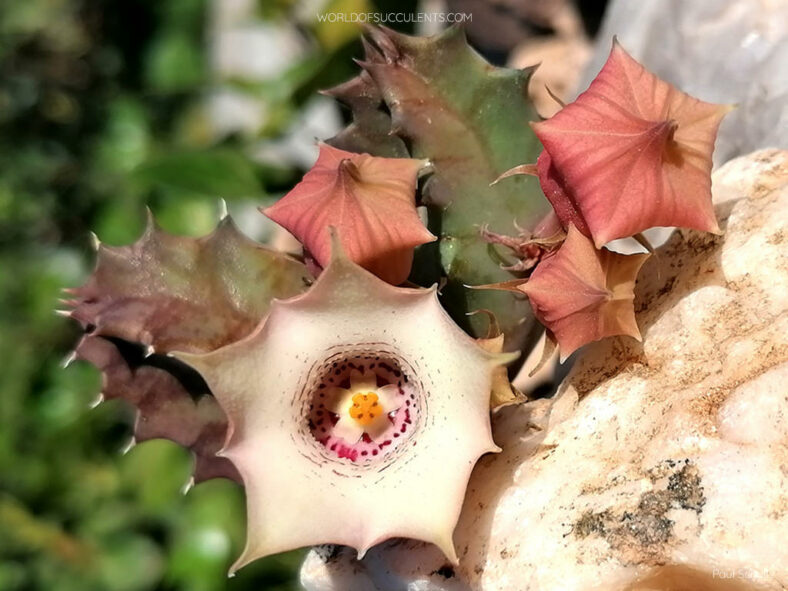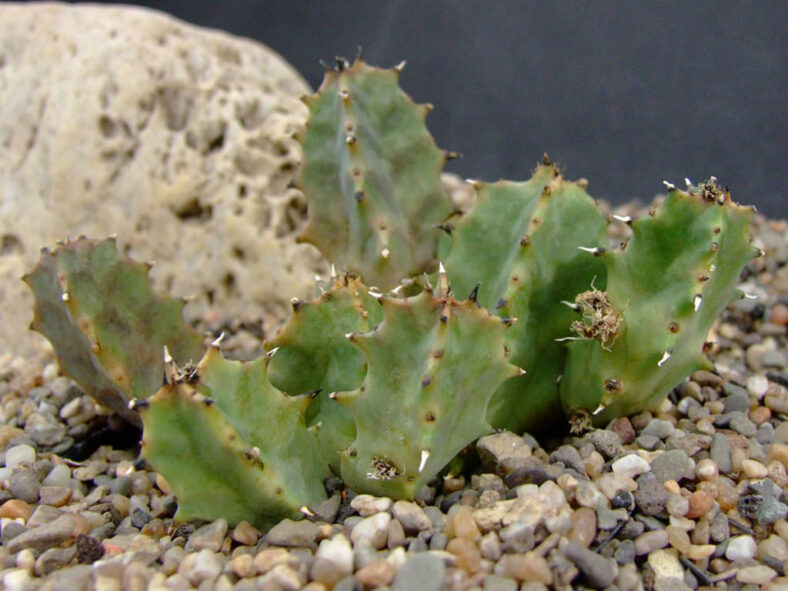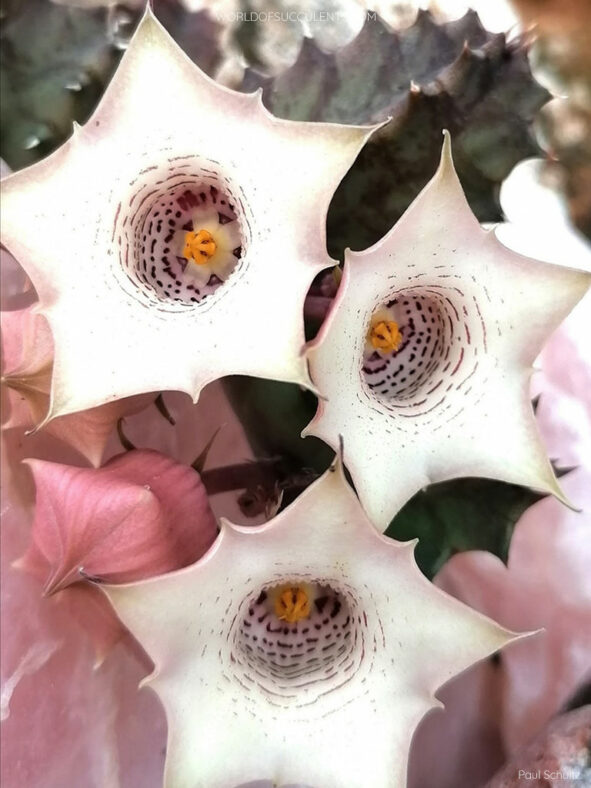Huernia quinta was first described in 1932 as a variety of Huernia scabra (now a synonym of Huernia thuretii) by Edwin Percy Phillips. In 1937, Alain Campbell White and Boyd Lincoln Sloane recognized them as separate species.
Scientific Name
Huernia quinta (E.Phillips) A.C.White & B.Sloane
Synonym(s)
Ceropegia quinta, Huernia scabra var. quinta
Scientific Classification
Family: Apocynaceae
Subfamily: Asclepiadoideae
Tribe: Stapeliae
Genus: Huernia
Etymology
The specific epithet "quinta" (pronounced KWIN-tuh) means "fifth" and refers to the five rings of spots decorating the corolla of the type specimen.
Origin
Huernia quinta is native to northern South Africa. It occurs in shallow soils in sandstone and granite outcrops in Limpopo and Mpumalanga provinces.
Description
Huernia quinta is a small succulent that forms a dense clump of grey-green to purplish stems with deltoid tubercles joined into almost always five angles. The tubercles are often spirally twisted along the stem, tapering into a stout, sharp, yellowish tooth. The stems are erect to decumbent and can grow up to 2.4 inches (6 cm) long and 0.8 inches (2 cm) thick, excluding teeth.
During the fall, Huernia quinta produces inflorescences of 3 to 20 flowers that develop in quick succession. The broadly bell-shaped flowers can reach a diameter of up to 1.2 inches (3 cm). On the outside, the corolla is smooth, pale brown to flesh-colored or green, and usually has 1 to 5 raised longitudinal veins running down the center of the lobe. The inside of the corolla is adorned with narrow, broken, concentric, maroon lines in and around the mouth of the tube on an otherwise almost wholly white background. The papillae inside the corolla usually have apical bristles that vary in length. The outer corona is white and somewhat translucent towards the tips, while the inner corona lobes are bright yellow.

How to Grow and Care for Huernia quinta
Light: Huernia quinta prefers bright light or partial shade during the hottest summer days. Too much sun can cause the stems to develop a protective pigmentation or get sunburned. Too little light leads to weak, thin stems and decreased flower production. When grown indoors, place the plant near the brightest window of your home.
Soil: The right soil is crucial to successful growing. Use a commercial potting soil mix for succulents, or prepare your own with 50 to 70 % mineral grit, such as coarse sand, pumice, or perlite.
Temperature: Huernia quinta thrives in warm outdoor environments with low to moderate humidity but does not like winter cold and should remain fairly dry and warm during its winter dormancy. It grows best in USDA Plant Hardiness Zones 10b to 11b, with average minimum winter temperatures ranging from 35 to 50 °F (1.7 to 10 °C).
Watering: This plant has typical watering needs for a succulent. During the growing season, water it thoroughly and allow the soil to dry between waterings. It goes dormant in winter and needs almost no water, about once a month.
Fertilizing: To keep it healthy and thriving, fertilizing during the growing season is a good idea. Feed with water-soluble fertilizer diluted to half the recommended strength.
Repotting: The plant will benefit from fresh potting soil every 2 or 3 years. Repot it in spring, just before the growing season. Pick a container with drainage holes.
Propagation: The best way to propagate Huernia quinta is by using stem cuttings. Take cuttings during the growing season to ensure good rooting. You can also start this plant from seeds, which is quite easy.
Learn more at How to Grow and Care for Huernia.
Toxicity of Huernia quinta
Huernia quinta has no toxic effects reported, so it is safe to grow around kids and pets.
Links
- Back to genus Huernia
- Succupedia: Browse succulents by Scientific Name, Common Name, Genus, Family, USDA Hardiness Zone, Origin, or cacti by Genus
Photo Gallery
Click on a photo to see a larger version.


